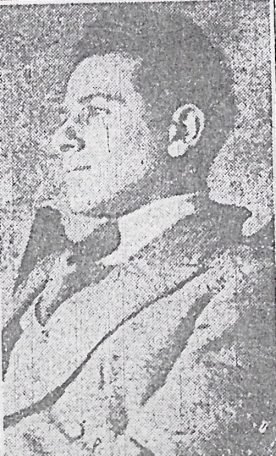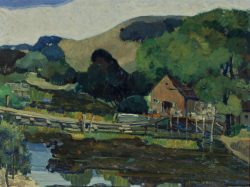Anthony Angarola, from a photograph reproduced in “Anthony Angarola, American, Modern, Painter, Is Teaching,” Minneapolis Journal, Nov. 26, 1922.

Anthony Angarola 1893-1929
Born into an Italian immigrant family in Chicago, Anthony Angarola began attending the Art Institute of Chicago as a teenager and continued his studies there both part- and fulltime until he finally graduated in 1917. Angarola first exhibited in the Art Institute’s annual exhibitions while still a student, in 1915. He won prestigious prizes at both the Art Institute and the Art Students’ League of Chicago, earning the respect of his artistic colleagues and the praise of critics for his sensitive landscapes and figural works.
A powerful sense of structure, decorative emphasis on two-dimensional form, and deep spirituality characterize Angarola’s individual brand of modernism, which reflects his awareness of Post-Impressionist, Fauvist, and expressionist art as well as his admiration for his American contemporary Arthur B. Davies. Angarola was also consciously indebted to the “primitive” painting of Renaissance masters, notably Hans Holbein, Giotto, Pisanello, and Pieter Brueghel. He was able to study them firsthand during a one-year stay in Europe, funded by a Guggenheim Fellowship, in 1928–1929. Shortly after his return to Chicago, the artist died suddenly.
During his short career Angarola exhibited widely and won numerous awards, but he sold few works. In addition to making book and newspaper illustrations, he supported himself by teaching in Minneapolis, Kansas City, and Milwaukee and at the Art Institute. A beloved teacher, he could be frustrated by what he perceived as his students’ timidity in developing individual artistic expression. Angarola transcended the categories of “modernist” and “conservative” into which the Chicago art scene often seemed divided throughout the 1920s. He joined the city’s artistic radicals in the breakaway “Salon de Refusés” exhibition in 1921 and later participated in numerous shows organized by the alternative Chicago No-Jury Society of Artists. Committed to portraying the American scene, Angarola was drawn to America’s social margins, painting sympathetic images of struggling immigrant communities and their impoverished neighborhoods and emphasizing the Christian theme of compassion in his religious images. Yet the meditative quality and decorative beauty of his compositions, as well as his gentle temperament, endeared Angarola to the most conservative critics, who commended what they perceived as the comparative sanity of his artistic modernism.
Wendy Greenhouse, PhD
